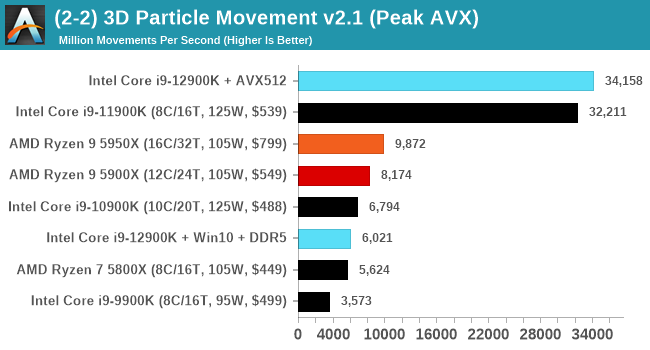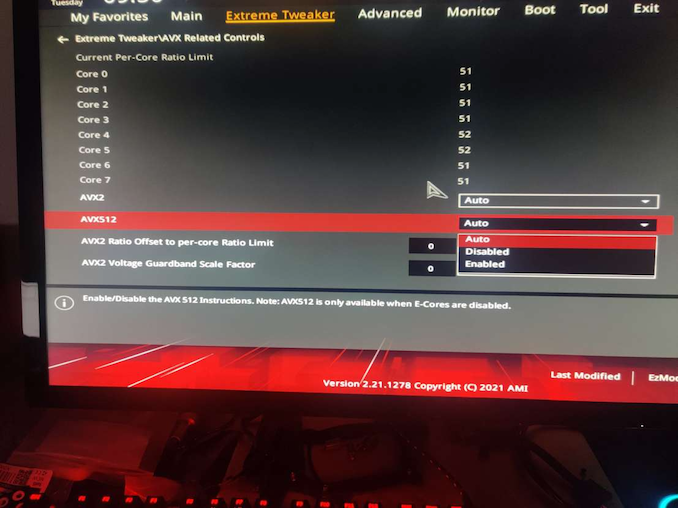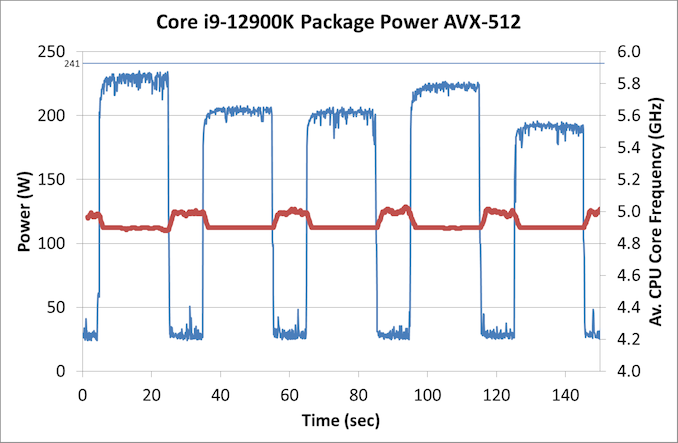The Intel 12th Gen Core i9-12900K Review: Hybrid Performance Brings Hybrid Complexity
by Dr. Ian Cutress & Andrei Frumusanu on November 4, 2021 9:00 AM ESTIntel Disabled AVX-512, but Not Really
One of the more interesting disclosures about Alder Lake earlier this year is that the processor would not have Intel’s latest 512-bit vector extensions, AVX-512, despite the company making a big song and dance about how it was working with software developers to optimize for it, why it was in their laptop chips, and how no transistor should be left behind. One of the issues was that the processor, inside the silicon, actually did have the AVX-512 unit there. We were told as part of the extra Architecture Day Q&A that it would be fused off, and the plan was for all Alder Lake CPUs to have it fused off.
Part of the issue of AVX-512 support on Alder Lake was that only the P-cores have the feature in the design, and the E-cores do not. One of the downsides of most operating system design is that when a new program starts, there’s no way to accurately determine which core it will be placed on, or if the code will take a path that includes AVX-512. So if, naively, AVX-512 code was run on a processor that did not understand it, like an E-core, it would cause a critical error, which could cause the system to crash. Experts in the area have pointed out that technically the chip could be designed to catch the error and hand off the thread to the right core, but Intel hasn’t done this here as it adds complexity. By disabling AVX-512 in Alder Lake, it means that both the P-cores and the E-cores have a unified common instruction set, and they can both run all software supported on either.
There was a thought that if Intel were to release a version of Alder Lake with P-cores only, or if a system had all the E-cores disabled, there might be an option to have AVX-512. Intel shot down that concept almost immediately, saying very succinctly that no Alder Lake CPU would support AVX-512.
Nonetheless, we test to see if it is actually fused off.
On my first system, the MSI motherboard, I could easily disable the E-cores. That was no problem, just adjust the BIOS to zero E-cores. However this wasn’t sufficient, as AVX-512 was still clearly not detected.
On a second system, an ASUS motherboard, there was some funny option in the BIOS.
Well I’ll be a monkey’s uncle. There’s an option, right there, front and centre for AVX-512. So we disable the E-cores and enable this option. We have AVX-512 support.
For those that have some insight into AVX-512 might be aware that there are a couple of dozen different versions/add-ons of AVX-512. We confirmed that the P-cores in Alder Lake have:
- AVX512-F / F_X64
- AVX512-DQ / DQ_X64
- AVX512-CD
- AVX512-BW / BW_X64
- AVX512-VL / VLBW / VLDQ / VL_IFMA / VL_VBMI / VL_VNNI
- AVX512_VNNI
- AVX512_VBMI / VBMI2
- AVX512_IFMA
- AVX512_BITALG
- AVX512_VAES
- AVX512_VPCLMULQDQ
- AVX512_GFNI
- AVX512_BF16
- AVX512_VP2INTERSECT
- AVX512_FP16
This is, essentially, the full Sapphire Rapids AVX-512 support. That makes sense, given that this is the same core that’s meant to be in Sapphire Rapids (albeit with cache changes). The core also supports dual AVX-512 ports, as we’re detecting a throughput of 2 per cycle on 512-bit add/subtracts.
For performance, I’m using our trusty 3DPMAVX benchmark here, and compared to the previous generation Rocket Lake (which did have AVX-512), the score increases by a few percent in a scenario which isn’t DRAM limited.

Now back in that Rocket Lake review, we noted that the highest power consumption observed for the chip was during AVX-512 operation. At that time, our testing showcased a big +50W jump between AVX2 and AVX-512 workloads. This time around however, Intel has managed to adjust the power requirements for AVX-512, and in our testing they were very reasonable:
In this graph, we’re showing each of the 3DPM algorithms running for 20 seconds, then idling for 10 seconds. Each one has a different intensity of AVX-512, hence why the power is up and down. IN each instance, the CPU used an all-core turbo frequency of 4.9 GHz, in line with non-AVX code, and our peak power observed is actually 233 W, well below the 241 W rated for processor turbo.
Why?
So the question then refocuses back on Intel. Why was AVX-512 support for Alder Lake dropped, and why were we told that it is fused off, when clearly it isn’t?
Based on a variety of conversations with individuals I won’t name, it appears that the plan to have AVX-512 in Alder Lake was there from the beginning. It was working on early silicon, even as far as ES1/ES2 silicon, and was enabled in the firmware. Then for whatever reason, someone decided to remove that support from Intel’s Plan of Record (POR, the features list of the product).
By removing it from the POR, this means that the feature did not have to be validated for retail, which partly speeds up the binning and testing/validation process. As far as I understand it, the engineers working on the feature were livid. While all their hard work would be put to use on Sapphire Rapids, it still meant that Alder Lake would drop the feature and those that wanted to prepare for Alder Lake would have to remain on simulated support. Not only that, as we’ve seen since Architecture Day, it’s been a bit of a marketing headache. Whoever initiated that dropped support clearly didn’t think of how that messaging was going to down, or how they were going to spin it into a positive. For the record, removing support isn’t a positive, especially given how much hullaballoo it seems to have caused.
We’ve done some extensive research on what Intel has done in order to ‘disable’ AVX-512. It looks like that in the base firmware that Intel creates, there is an option to enable/disable the unit, as there probably is for a lot of other features. Intel then hands this base firmware to the vendors and they adjust it how they wish. As far as we understand, when the decision to drop AVX-512 from the POR was made, the option to enable/disable AVX-512 was obfuscated in the base firmware. The idea is that the motherboard vendors wouldn’t be able to change the option unless they specifically knew how to – the standard hook to change that option was gone.
However, some motherboard vendors have figured it out. In our discoveries, we have learned that this works on ASUS, GIGABYTE, and ASRock motherboards, however MSI motherboards do not have this option. It’s worth noting that all the motherboard vendors likely designed all of their boards on the premise that AVX-512 and its high current draw needs would be there, so when Intel cut it, it meant perhaps that some boards were over-engineered with a higher cost than needed. I bet a few weren’t happy.
Update: MSI reached out to me and have said they will have this feature in BIOS versions 1.11 and above. Some boards already have the BIOS available, the rest will follow shortly.
But AVX-512 is enabled, and we are now in a state of limbo on this. Clearly the unit isn’t fused off, it’s just been hidden. Some engineers are annoyed, but other smart engineers at the motherboard vendors figured it out. So what does Intel do from here?
First, Intel could put the hammer down and execute a scorched earth policy. Completely strip out the firmware for AVX-512, and dictate that future BIOS/UEFI releases on all motherboards going forward cannot have this option, lest the motherboard manufacturer face some sort of wrath / decrease in marketing discretionary funds / support. Any future CPUs coming out of the factory would actually have the unit fused out, rather than simply turned off.
Second, Intel could lift the lid, acknowledge that someone made an error, and state that they’re prepared to properly support it in future consumer chips with proper validation when in a P-core only mode. This includes the upcoming P-core only chips next year.
Third, treat it like overclocking. It is what it is, your mileage may vary, no guarantee of performance consistency, and any errata generated will not be fixed in future revisions.
As I’ve mentioned, apparently this decision didn’t go down to well. I’m still trying to find the name of the person/people who made this decision, and get their side of the story as to technically why this decision was made. We were told that ‘No Transistor Left Behind’, except these ones in that person’s mind, clearly.












474 Comments
View All Comments
Wrs - Saturday, November 6, 2021 - link
@Netmsm I'll leave that to the market as I don't foresee using any of the 3 that soon lol. It would stand to reason that if one product is both cheaper and better, it would keep gaining share at the expense of the other. If that doesn't happen I would question the premise of cheaper + better. And seeing as it's a major market for Intel, I have little doubt they'll adjust prices if they do find themselves selling an inferior product.Netmsm - Sunday, November 7, 2021 - link
That's right. We always check performance per watt and per dollar. A product should be reasonable with respect to its price and power consumption, this is a must.12900k can consume up to 241 which is very closer to Threadripper not Ryzen 5900's TDP and yet competing with chips having 125 TDP! What a parody this is!
I can't disregard and throw away efficiency factor, that's all.
Spunjji - Friday, November 5, 2021 - link
Seeing this has made me very interested to see the value proposition Alder Lake will be offering in gaming notebooks. I was vaguely planning to switch up to a Zen 3+ offering for my next system, but this might be enough to make me reconsider.EnglishMike - Thursday, November 4, 2021 - link
<blockquote>re: Enterprise: Considering power consumption, it's like a Pyrrhic victory for Intel.</blockquote>Why? This is not an enterprise solution -- that's the upcoming Sapphire Rapids Xeon processors, a completely different CPU platform.
Sure, if all you're doing is pegging desktop CPUs at 100% for video processing or a similar workload, then Alder Lake isn't for you, but the gaming benchmarks clearly show that when it comes to more typical desktop workloads, the i9 12900k is inline with the top of the line AMD processors in terms of power consumption.
Netmsm - Thursday, November 4, 2021 - link
and who in his right mind would believe that upcoming Xeon processors can bring revolutionary breakthrough in power consumption?!EnglishMike - Friday, November 5, 2021 - link
And that, my friend, is a great example of moving the goalposts.We'll have to see what Intel offers re: Xeon's but one thing is for sure, they're going to offer a completely different power profile to their flagship desktop CPUs, because that's the nature of the datacenter business.
Netmsm - Saturday, November 6, 2021 - link
Of course the nature of enterprise won't accept this power consumption. In PC world customers may not care how ineffective a processor is. Intel will reduce the power consumption but the matter is how its processor will accomplish the job! We see an unacceptable performance to watt in Intel's new architecture that needs something like a miracle for Xeon's to become competitive with Epyc's.Wrs - Saturday, November 6, 2021 - link
No miracle is needed... just go down the frequency-voltage curve. Existing Ice Lake Xeons already do that. What's new about Sapphire Rapids is not so much the process tech (it's still 10nm) but the much larger silicon area enabled per package due to the EMIB packaging. That's their plan to be competitive with Epyc and its multichip modules.Netmsm - Sunday, November 7, 2021 - link
And what will happen to performance as frequency-voltage curve goes down?Just look at facts! With about 100w more power consumption Intel's new architecture gets itself in front of Zen 3 by a slight margin in some cases that lucidly tells us it can never reduce power consumption and yet beat Epyc in performance.
Wrs - Sunday, November 7, 2021 - link
@Netmsm I'm looking at facts. The process nodes are very similar. One side has both a bigger/wider core (Golden Cove) and a really small core (Gracemont). The other side just has the intermediate size core (Zen 3). As a result, on some benchmarks one side wins by a fair bit, and on other benchmarks, the other side takes the cake. Many benches are a tossup.In this case the side that theoretically wins on efficiency at iso-throughput (MC performance) is the side that devotes more total silicon to the cores & cache. When comparing a 12900k to a 5950x, the latter has slightly more area across the CCDs, about 140 mm2 versus around 120 mm2. The side that's more efficient at iso-latency (ST/lightly threaded) is the one that devotes more silicon to their largest/preferred cores, which obviously here is ADL. In practice companies don't release their designs at iso-performance, and for throughput benchmarks one may encounter memory and other platform bottlenecks. But Intel seems to have aggressively clocked Golden Cove such that it's impossible for AMD to reach iso-latency with Zen 3 no matter the power input (i.e., you'd have to downclock the ADL). That has significant end-user implications as not everything can be split into more threads.
The Epyc Rome SKUs are already downclocked relative to Vermeer, like most server/workstation CPUs. Epyc Rome tops out at 64 Zen3 cores across 8 chiplets. Sapphire Rapids, which isn't out yet, has engineering samples topping out at 80 Golden Cove cores across 4 ~400mm2 chiplets. Given what we know about relative core sizes, which side is devoting more silicon to cores? There's your answer to performance at iso-efficiency. That's not to say it's fair to compare a product a year out vs. one you can obtain now, but also I don't see a Zen4 or N5 AMD server CPU within the next year.